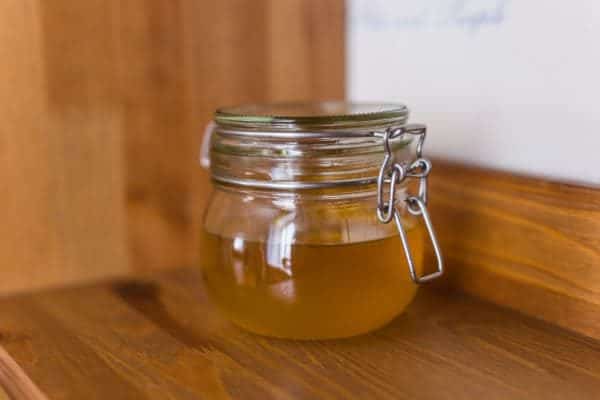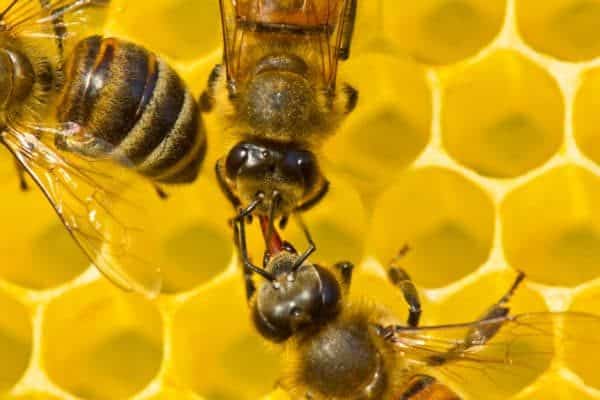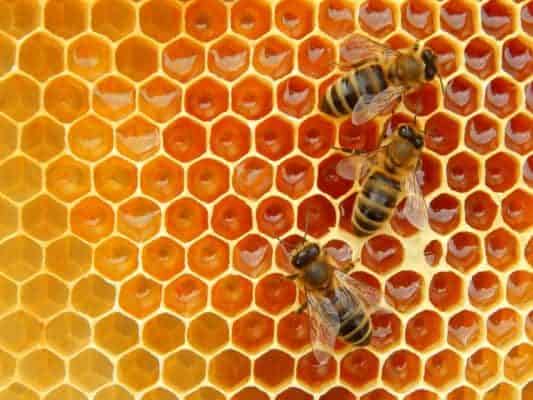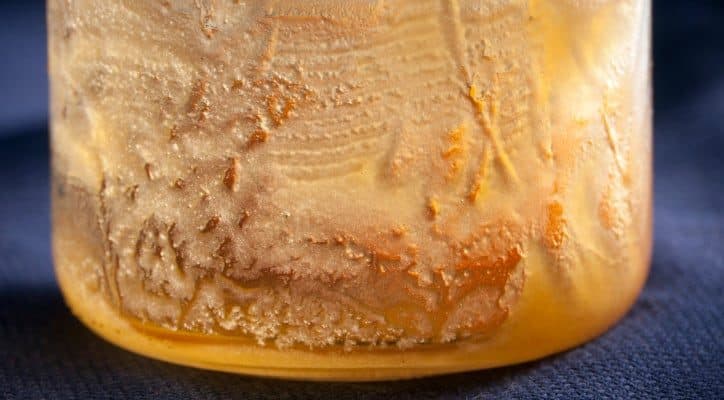Honey has been used for thousands of years as an antifungal, anti-bacterial, and as a preserving substance. But what happens when you have stored your honey for too long?
Maybe you have found a jar on the back of the shelf and wonder if it is still good enough to consume.

Does Honey Expire? Real, raw honey is naturally preserved and doesn’t expire. In fact, archeologists discovered honey in ancient Egyptian tombs, thousands of years old, preserved, and edible. Honey is 80% sugars and 17-18% water, this doesn’t support microbiological growth, meaning honey can’t spoil, expire or go bad.
So why does shop-bought honey have an expiration date, why does honey crystalize, and why does it seem to change throughout the year?
Below we will discuss the eternal shelf life of this amazing food and all the variations that it goes through.
Why Does Pure Honey Last So Long?
There are a few key factors that prevent natural honey from going bad.
These include:
- Honey has a high sugar content
- Honey has a low moisture content
- The pH level of honey
- Bees Produce Enzymes That Suppress Bacterial Growth
1. Honey Has A High Sugar Content
Honey is about 80% sugar. Sugar does not support many types of microbial growth and has been found in some studies that sugars do not only not support bacterial growth, but can inhibit its growth in surrounding areas.
Overindulging in high sugar foods can have a negative effect on the good microbes in your gut for this reason. It is also the same reason why refined sugar, like honey, is an everlasting food.
Sugars are hygroscopic, which means that they contain very little moisture in their natural state, but can readily absorb it if left exposed.
What does this mean? It means honey has a high osmotic pressure, which results in the sugars dehydrating microbes because the sugar absorbs the water from the cells.
2. Honey has A Low Moisture Content
Honey is around 17-18% water which is relatively low and has very little movement within the honey.
Amina Harris, from the Honey and Pollination Centre at the Robert Mondavi Institute at the University of California, points out that because honey, in its natural form as a low moisture content very few bacteria or microorganisms can survive in it.
She states that they are essentially smothered by the environment and simply die.
In order for something to go bad, there needs to be something within it that can go bad or spoil.
If organisms do not survive long enough in an environment there is no chance for the environment to spoil.
3. The pH Level Of Honey
Honey has a pH level of between 3.4 – 6.1 with an average of 3.9, which is very much on the acidic side. Most bacteria can not live at acidity levels like this high and will therefore not thrive and die.
Gluconic acid, which is produced during nectar ripening is the primary reason for these acidity levels.
Bacterial organisms such as C. diphtheriae, E.coli, Streptococcus, and Salmonella, cannot live in acidic environments as they see them as hostile. This is why honey is often used for burn wounds and ulcers.
What is interesting here is that Molasses, the by-product of sugar cane, is also extremely hygroscopic and has a high acidity level, but will eventually spoil. The difference in the case of Honey is the fact that it is produced by bees.
4. Bees Produce Enzymes That Suppress Bacterial Growth
During the production of honey, bees secrete an enzyme called glucose oxidase into the nectar, which is used to help preserve the honey.
When bees regurgitate nectar, this enzyme mixes with the nectar in the honeycomb and breaks it down into two by-products: gluconic acid and hydrogen peroxide.

The hydrogen peroxide, then, creates another bacterial fighting property within the honey.
In addition to this chemical, honey has been found to contain a number of antibacterial agents such as flavonoids, methylglyoxal, bee peptides, as well as others.
All these additions to honey are what make this sugary syrup stand out among other long lasting food products.
On a side note, if you are wondering if the honeycombs that the bees store honey in can go bad, then we have an article that would be worth checking out called, Can Beeswax Go Bad?
What Can Make Honey Go Bad?
Although honey has outstanding antibacterial properties, there are some instances that can cause it to go bad. In these circumstances, consuming the honey may make you sick.
These circumstances include:
- Extracting honey too early
- Contaminated Honey
- Toxic compounds in the honey
- Incorrect storage of honey
- Adulteration and pasteurization of honey
1. Extracting Honey Too Early
Extracting the honey from a hive too early is a wonderful way to reduce its shelf life, and should not be done.
If you have ever looked inside a hive and noticed frames with uncapped cells, this is an indication that the honey is not yet ready to be extracted.
Why? If a cell is uncapped, the nectar has not been properly dehydrated by the bees and therefore is not in a good condition to be stored for long periods of time.
Extracted honey with high moisture content is prone to fermentation.
Going to a store and noticing that the honey bottles are swollen is an indicator that there was a high percentage of water in the honey when extracting (25% or over).
In this case, the honey should not be eaten as the chemical compound structure has changed. Not only will it taste bad, but it could also possibly make you sick.

The best way to avoid this when harvesting your own honey is to ensure that 95% of the cells have been capped by the bees and giving the structure a light frame shake in order to remove the uncapped honey from the frame.
Alternatively, leave the frames with too many uncapped cells for another day down the track.
2. Contaminated Honey
As mentioned before, honey has an array of antimicrobial properties. This, however, does not mean that there are zero bacteria present within it.
There are some microbes present in honey such as yeast and molds that stem from pollen, dust, dirt, flowers, and the bees digestive tract.
These bacterias are only found in small amounts and as mentioned are not able to multiply, so should not pose any health problems.
The one exception to this, according to the International Journal of Food Microbiology is a neurotoxin called C. botulinum where the spores are found in 5 – 15% of honey samples.
Only ever found in small amounts, these spores pose no threat to adults, but young children (under the age of one) stand the risk of developing infant botulism.
For this reason, honey is not suitable for infants under the age of 1.
3. Toxic Compounds Found In The Honey
The plants that bees collect their nectar from can affect the health quality of the honey that is produced.
Perhaps you have heard of the term “mad honey”.
Mad honey is formed when bees collect nectar from plants that contain grayanotoxin, which I commonly found in the Ericaceae family.
This honey can have a hallucinogenic effect and lead to nausea, dizziness, and in extreme cases blood pressure and heart problems.
Although this may seem threatening, mad honey has been used as a natural medicine since 2100 BC as an aphrodisiac and for gastrointestinal disorders.
Mad honey is produced commercially in some countries and should not be worried about unless you are harvesting honey from a wild hive in an area that you are not familiar with.
Another toxin that is found in honey is HMF (hydroxymethylfurfural), which is produced during the aging process.
There are mixed results from this toxin, as some research showed results of damage to cells and DNA, while other studies concluded positive results such as antioxidative, anti-inflammatory, and anti-allergy properties.
Because of these varied reports, the averages suggest that every kilogram of honey may contain 40 mg of HMF. This is set in place to eliminate the possibility of negative affect.
4. Incorrect Storage Of Honey
Once again, one of honey’s strongest preservation properties is its low moisture content.
If honey is stored in unsealed containers, the moisture content is likely to slowly increase, thus resulting in fermentation.
Leaving honey open to the environment exposes it to the bacteria and microbes from surrounding areas. As the water content of the poorly stored honey rises, these microbes will be able to reproduce and turn the honey bad.
In addition to exposing it to outside bacteria, heating honey at high temperatures speeds up the degradation of color and flavor. Heating honey in this way is also known to increase the HMF levels.
5. Adulteration And Pasteurization Of Honey
A practice commonly found in store-bought honey products is that it is pasteurized. This is done in order to slow down the natural granulation process (crystallization) of honey.
Although this may make the honey smoother, and seem to have a longer shelf-life, it is known to destroy antioxidants, and reduce the honey’s health benefits.
The process of pasteurization requires heating a substance at high heat in order to change the molecular structure. As mentioned above, this process is likely to increase the HMF content of the honey.
Adulteration of honey is another commonly found process when it comes to cheap store-bought honey.
Because producing honey is a timely and expensive process, many companies use artificial sweeteners in order to reduce costs and increase the quantity.
Bees are sometimes fed with sugar syrups, or alternatively, sugar syrups are directly added to the finished product.
This process greatly decreased the shelf-life of the honey as it is no longer natural and pure.
Why Does Shop Bought Honey Have An Expiration Date?
So if honey does not expire, then why does the jar or bottle have an expiration date on it?
There are three main reasons why store-bought honey has an expiration date: Law, purity, and crystallization.
In some countries such as in Europe, food date expiration stamps are mandatory. In this case, the local law requires all consumable products to show either a best before or expiration date
On the other hand, countries such as the USA do not have the same requirements as the federal law does not require dating on all products. Therefore pure honey products may not contain these stamps.
The purity of honey may be the reason that there is an expiration date. As mentioned before, if honey is adulterated or pasteurized, there is a higher chance of fermentation and or contamination.
Impure or non-natural honey should always contain an expiration date due to its capability of going off.
Another main reason you will find an expiration date, or more likely a best before date on store-bought honey is because of crystallization.
This is a natural process in the aging of honey and a good indicator that it is pure and unpasteurized.
Can Honey Be Used After The Expiration Date?
A rule of thumb to whether honey can be used after the expiration date is if it is natural and pure or if it is not.
If honey has additives, has fermented, or has been changed in any way then it is not recommended to use after the expiration date.
However, expired raw honey or crystalized honey is still okay to use, providing you know and trust the supplier.
If you are not sure what raw honey is, then check out this article we have written on this, What Is Raw Unfiltered Honey?
What Is Crystallized Or Candied Honey?
So what exactly is candied honey and how can you use it once it has been crystallized?
Honey, as mentioned many times, has a high concentration of carbohydrates (sugar).
Remember when we spoke about the hygroscopic properties of sugar? It is this property that leads to honey crystallization.

The glucose sugars in honey are less soluble than the fructose sugars. Through time, the fructose sugars absorb most of the moisture and separate from the glucose.
When the glucose separates from the solution it forms crystals to create a balanced state within the sealed environment.
Another natural process you may see in your honey is a color change. This color change is often due to storage temperature.
Honey stored in hotter environments will slowly start to darken. Darkened honey may change in texture and flavor but does not affect quality.
If you live in a varied climate, you are likely to experience this change in natural honey as you move from winter into hot summer months.
Can Candied Honey Still Be Used?
Candied honey is a common term used to describe honey that has crystallized. There is nothing wrong with crystalized honey, and it can still be eaten. You have the option of either decrystallizing it or eating it in its crystallized form.
The only concern is that once the honey has crystallized, honey has a higher chance of fermentation because of the released water.
Crystallized honey will also appear lighter and have a different taste, although this is not in any way related to the safety of the honey.
How To Uncandy Honey?
There are a few methods you can use to uncandy honey, all of which include heating the honey up.
One of these methods includes using a microwave, however, this is not an ideal process as it may cause the honey to boil as well as destroy beneficial antioxidants in the honey.
What is the best way to decrystallize your honey?
Simply take your jar of honey and place it in hot water. One recommendation is to take off the lid and stir it periodically until the honey returns to a liquid state.
When doing this, make sure that the water does not reach the top of the jar, as you do not want to add water into the honey.
One downside of this method is that because the jar is open, external moisture from the environment may enter the jar.
A way to avoid this is by keeping the jars tightly sealed and submerging them in hot water.
This method may take a bit longer but will make sure that there is a “closed system” and that the glucose in the jar only binds with the water that is already present.
Decrystallizing honey may take a few hours and require a few water changes, but this is a safe method to avoid the overheating of the honey.
As can be concluded from all the above information, store-bought honey can be a problem, and therefore it is better to buy your honey from a local beekeeper.
In Conclusion, Why Is It Best To Buy Honey From Your Local Beekeeper?
Let us look at the benefits of buying raw honey from your local beekeeper:
Shelf life: Raw honey, when stored properly will last forever. Any food that does not go off in an absolute win.
Health Reasons: Natural honey is high in antioxidants, while pasteurized and adulterated honey may contain hazardous toxins.
Store-bought honey may be imported: Buying imported honey may come from somewhere with different standards and regulations. These regulations may change honey quality as well as affect the ethical process of beekeeping
Store-bought honey may be blended: Although this may not be a problem to you, there is no way of knowing the floral origin of the honey and therefore antioxidant properties and crystallization times may vary.
Supporting local: Supporting small local products has major benefits for communities. They can guarantee the best quality and keep money within the local economy.
Buying pure, raw, and natural honey from your local beekeeper will allow you to know that your honey is ethically sourced and of the best quality.
So support your local beekeepers, buy local raw honey and have the confidence that the honey you have bought is good for you and not expire any time soon.
